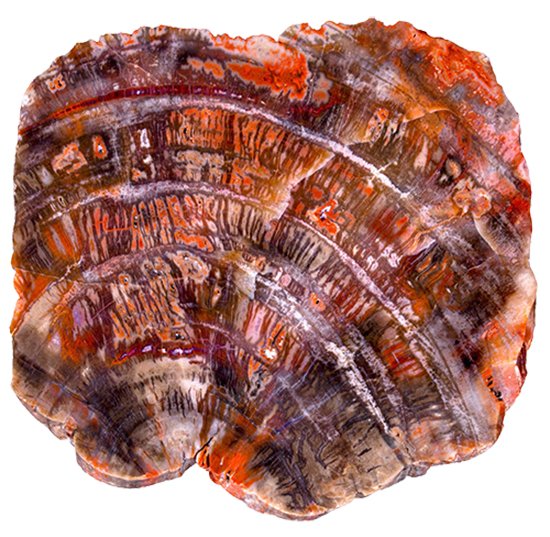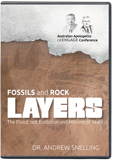
Petrified Forest National Park—Painting A Different Picture
Looking at this landscape through biblical glasses, we see a rainbow of evidence confirming the global flood.
When the first migrants after Babel arrived in northeastern Arizona, imagine their wonder at the sight of rainbow-colored petrified logs scattered across the “painted desert” badlands. Colorful gray, red, pinkish-orange, blue, purple, and green layered hills; flat sandstone-topped mesas; sculptured buttes; and hoodoos (tall, thin spires of soft rock with a cap of hard rock) make this deeply eroded, barren landscape a breathtaking sight to behold.
Fast forward about 4,000 years to the mid-nineteenth century when a US team surveyed an east-west route across the area. This route paved the way for roads and a railroad which would bring hordes of tourists filled with the same wonder at this painted desert. In 1906, the US government turned the land into Petrified Forest National Park, in part to supervise tourists eager to pocket chunks of the fossilized wood as souvenirs.
This desert still attracts nearly a million visitors every year, each wondering the same thing: How did these hills get “painted”? And how did the colorful petrified logs form? When visitors venture to the trails, the national park signs tell them a story of slow processes over millions of years. However, this landscape actually paints a different picture—one of a violent catastrophe that overtook this area not that long ago.

Each year, Petrified Forest National Park attracts a million visitors eager to survey the nearly rainbow-colored logs and landscape.
Looking at the Land
To decipher the origin of those petrified logs, let’s look at the land the logs are lying on. The severely weathered rock layers of the painted desert belong to what geologists call the Chinle Formation. These sedimentary layers consist of relatively soft, colorful mudstones; fine-grained siltstones; and occasional thin, hard sandstone layers in gray, white, or brown.
Secular geologists claim that the vivid layering in the mudstones represents ancient soil horizons. They say that over millions of years the various sediment layers successively weathered to form soils and were subsequently buried and compressed to form these colorful mudstone layers. But this is the first clue that the secular story about this desert is incorrect.
The uniform coloring and the mudstone in each layer are inconsistent with an evolutionary interpretation.
The uniform coloring and the mudstone in each layer are inconsistent with their evolutionary interpretation. Rather, the red and green layers generally contain the same amount of iron and manganese, but the differences in color depend on how much oxygen was in the waters when the mudstone layers were deposited. More oxygen caused the iron minerals in the mud to essentially rust, producing red mudstone, while a lack of oxygen produced a greenish or bluish hue. Other color variations came from similar effects on the manganese when the mud was deposited.
The thin, hard sandstone layers capping many mesas, buttes, and hoodoos are often cross-bedded. Cross-beds are sloping layers that are the preserved fronts of underwater sand dunes or waves, indicating that fast-moving water deposited the sand. Some of these sandstone layers contain petrified logs, as well as cobbles (rounded rocks 2.5–10 inches [6–25 cm] in diameter). Large, heavy debris, such as logs and cobbles, required fast-moving water currents to transport them.
Also significant is the presence of volcanic ash in some of the sandstones and siltstones. Many of the mudstones contain the mineral bentonite, known for forming when volcanic ash decomposes. Because explosive volcanic eruptions produce such ash, some volcanoes must have been explosively erupting when these sediments were deposited—but more about volcanic ash later.
Once Upon a Long Time Ago . . .
Visitors to Petrified Forest National Park will spot thousands of petrified logs dotting the painted desert landscape, including those poking from some cliffs. Most of the logs now exposed at the surface are broken into segments. As the softer sedimentary layers surrounding the logs shifted and settled, the stress on the rigid logs caused them to fracture. The sediments subsequently eroded from around the logs, leaving them lying across the ground. But how did the original trees fall, get buried in these sediments, and become petrified in a stunning display of rainbow colors?
According to the secular story on the national park signs, a lush landscape flourished here in the past with coniferous trees up to 9 feet in diameter reaching almost 200 feet into the sky. Numerous rivers flowed through this luscious lowland where galleries of trees, ferns, and horsetails provided food and shelter for many insects, reptiles, amphibians, and other creatures.
Over time, winds knocked over trees. Some fell into the rivers and got washed downstream, their branches and roots getting knocked off along the way. Meanwhile, distant volcanoes farther west spewed tons of ash into the atmosphere. Carried to the area by winds, the ash settled into the river sediments.
Before they could decompose, some of the logs were buried in these river sediments. Secular geologists admit that the felled logs had to be quickly covered by sediments in an anaerobic (oxygen-deficient) environment that would have slowed decay. Biblical geologists agree with the rapid burial of these logs, but in flood, not river, sediments. Many of the logs are oriented in the same direction, testifying to the rapid water currents that carried them with the sediments in which they were then buried.
However, all geologists agree that the volcanic ash content in the enclosing sediments became significant in the next stage of the process. The groundwater in the sediments dissolved silica from the mixed-in volcanic ash and carried it in to replace the woody structure within the buried logs, a process that can be quite rapid. Tiny quartz crystals from the solution solidified to fill in hollows, cracks, and eventually even the interior of the wood cells, sometimes replacing the cell walls. The resulting petrified logs show many details of their original surfaces and, occasionally, the internal structure of the wood cells. Traces of iron, manganese, and other elements were incorporated in the quartz as the logs were petrified, creating the brilliant rainbow of colors.

Traces of iron, manganese, and other elements incorporated in quartz give the petrified logs their swirls of color.
Explosive Evidence
Volcanic phenomena, such as hot volcanic ash flows from an explosive eruption, cause widespread devastation and fast burial under ash. The eruption of Mount St. Helens on May 18, 1980, demonstrated the devastating effect that such a volcanic explosion can have on a forest. The extremely high temperatures of the explosive gases from the Mount St. Helens eruption charred many logs, while floodwaters felled, stripped, and buried logs and other debris even many miles downstream of the volcano.
Many logs in one Petrified Forest National Park location are encrusted with charcoal as though they had been burned by fire, evidence of the hot blast of explosive ash flows. Secular geologists haven’t recognized the indication that volcanic eruptions likely felled many of these now petrified trees, an additional factor in their rapid burial in flood sediments.
The True Story
According to the secular interpretation, this area covered by the Chinle Formation represents a former lowland lush with forests and flowing rivers. Secular geologists claim that during about 17 million years, trees were occasionally felled and logs buried in the slowly accumulating sediments, including the ash from periodic explosive eruptions from nearby volcanoes.
However, geologists never witnessed any part of that scenario. It is merely an interpretation based on assumptions. They assume that only present-day slow processes can explain the sediment deposits and buried logs, and they assume that radiometric dating methods give reliable absolute ages based on the further assumption that radioactive decay has always been constant at today’s exceedingly slow rates.
On the other hand, we do have an eyewitness of earth’s history, the Creator God who never lies (Titus 1:2). His Word tells us that he sent a catastrophic global flood to destroy the earth along with humankind (Genesis 6:13) only about 4,300 years ago. His account of that global cataclysm describes fountains breaking up the earth’s crust (involving humongous volcanic eruptions) and waters covering the hills and mountains under the heavens so that all land-dwelling, air-breathing flesh outside the ark died (Genesis 7:11–12, 17–22).
Stumps, Roots, and Other Fossils
Captivated by the petrified trees, visitors often overlook the large, somewhat scattered petrified stumps. Some stumps have the remains of spread-out root systems. Geologists claim these roots indicate the trees grew in situ (in place) in former soils but were subsequently buried by accumulating mud and were petrified. However, that is not the only valid interpretation, especially because the mudstones lack evidence of having ever been soils. Furthermore, all that remains of the original roots are molds filled with iron oxides.
Just as likely, the root ends were broken off and the stumps were transported upright with the remnants of their root systems. The rather wide spacing of the stumps is consistent with their rapid transport and catastrophic deposition during the flood. Some horizons (layers) within the mudstones also show traces of unattached roots, indicating that they were broken off tree stumps when they were ripped up and washed away.
During the catastrophic eruption of Mount St. Helens in 1980, trees were violently shattered and ripped out of the ground. Then, some of their large stumps were transported and buried (in upright growth positions) by mudflows that carried them many miles from where they grew.
In addition to stumps and roots, this eroded, barren landscape has also yielded a plethora of other fossils all buried together. More than 200 different fossil plant types have been found in the Chinle Formation, including many remains of leaves, stems, cones, pollen, seeds, and amber of the lycopod, fern, conifer, cycad, ginkgo, and other plant groups. Among the vertebrate animal fossils are fish, amphibians, and many reptiles (including some dinosaurs).
Same Evidence—Different Worldviews
Now let’s look again at the evidence through these biblical glasses. The Chinle Formation, in which these petrified logs are buried, covers an area of at least 400,000 square miles (1 million square kilometers), stretching from Nevada to Texas and Oklahoma, and from Arizona and New Mexico to Colorado, Wyoming, and Kansas. Many tens of thousands of logs were rapidly buried and petrified in sediments, including in the Chinle’s Shinarump conglomerate member, over such a vast area containing huge quantities of ash from devastating volcanic eruptions.
This is exactly the evidence we would expect to observe today based on the Bible’s description of the global flood cataclysm. Furthermore, we have also observed what the small-scale Mount St. Helens explosive eruption achieved. And scientists have reproduced the rapid petrification of wood with silica from hot waters.
When it comes to what caused these thousands of colorful petrified logs and hills, the evidence for a global flood is totally consistent with the truth of God’s Word.
Take note that though evolutionists and creationists are looking at the same evidence, they have two different interpretations of that evidence. As we look at the evidence, we either trust the account of earth’s history in God’s absolute Word or we trust man’s fallible ideas about the past. When it comes to what caused these thousands of colorful petrified logs and hills, the evidence for a global flood is totally consistent with the truth of God’s Word.
Does it really matter how those petrified logs got there? Absolutely, because your worldview has eternal consequences. God the Creator cannot tolerate man’s rebellion. Wickedness brought not only man’s punishment with death but also the destruction and renovation of the whole earth. We should take heed when God warns that in the future, he will judge man’s wickedness again but this time by fire to burn up the whole earth and create a new one (2 Peter 3:10–13).
Though the rainbow-colored logs in this painted desert remind us of God’s judgment, they also remind us of God’s promise of salvation. Just as he preserved Noah and the animals in the ark through the flood, God has provided for our eternal salvation by sending his Son to die and rise again from the dead, rescuing us from the coming judgment. Have you repented of your rebellion and disobedience and put your trust in God’s Son, Jesus Christ, for your eternal salvation?
From Wood to Rock
The rapid process by which growing trees were turned into petrified logs during the flood involved three steps.

- The flood waters violently ripped up and broke the trees, swiftly transporting the debris. Stumps and logs were then buried rapidly in wet sediment layers made of sands and muds as well as ash from nearby volcanic eruptions.
- The water in the wet sediment layers was saturated with chemicals, particularly silica from the decomposing volcanic ash, and quickly permeated through the wood of the buried stumps and logs. As the flood ended, the water subsequently evaporated, leaving behind the silica filling and replacing the wood.
- As the flood waters rapidly retreated off the continents into today’s ocean basins, massive erosion shaped the emerging land surface, eventually exposing the petrified logs at today’s topographical surface.
Sources
Chadwick, A. V., and L. R. Brand. “Fossil Tree Orientation in the Chinle Formation.” Origins 1, no. 1 (1974): 22–28.
Colbert, E. H., and R. R. Johnson, editors. “The Petrified Forest Through the Ages.” Museum of Northern Arizona Bulletin 54, Flagstaff, Arizona (1985).
Martz, J. W., et al. “Geologic Map of Petrified Forest National Park, Arizona.” Arizona Geological Survey Contribution Report CM-12-A, with one 1:50,000 scale map sheet (2012).
Parker, W. G., S. R. Ash, and R. B. Irmis, editors. “A Century of Research at Petrified Forest National Park 1906–2006: Geology and Paleontology.” Museum of Northern Arizona Bulletin 62, Flagstaff, Arizona (2006).
Answers Magazine
July–August 2020
It’s always nice to have something as humble as the llama helping to guard the truth of God’s Word.
Browse Issue SubscribeRecommended Resources

Answers in Genesis is an apologetics ministry, dedicated to helping Christians defend their faith and proclaim the good news of Jesus Christ.
- Customer Service 800.778.3390
- © 2024 Answers in Genesis







